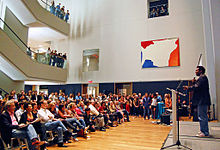Mint Museum Randolph
 | |
| Established | 1936 |
|---|---|
| Location | 2730 Randolph Road Charlotte, North Carolina 28207 |
| Type | Art |
| Director | Todd A. Herman, President & CEO |
| Website | http://www.mintmuseum.org/ |
Mint Museum Randolph resides in a federal style building that once housed the Charlotte Mint. Opening in 1936, it was the first art museum in North Carolina, USA. [2] The permanent collections include American Art, Ancient American Art, American and European ceramics, American and European Decorative Art, North Carolina Pottery, historic costume and fashionable dress and accessories, African Art, Asian Art, historic maps, Contemporary art, and photography. The companion Mint Museum of Craft + Design focuses on contemporary craft.
Collection highlights

The Mint Museum is the largest visual arts institution in Charlotte [3] and holds the largest public collection of Charlotte-born artist Romare Bearden's work. [4]
The American Art collection comprises approximately 900 works created between the late 1700s and circa 1945. It includes portraiture of the Federal era, 19th century landscapes, and paintings from the group known as "The Eight" [5] (Robert Henri, George Luks, William Glackens, John Sloan, Everett Shinn, Maurice Prendergast, Ernest Lawson, and Arthur Bowen Davies). Additional highlights in this area include works by John Singleton Copley, Gilbert Stuart, Thomas Sully, and Hudson River School painters Thomas Cole and Sanford Gifford. [6]
The Art of the Ancient Americas collection includes roughly 2,000 objects from more than 40 cultures, spanning more than 4,500 years. The collection includes body adornments, tools, ceramic vessels, sculpture, textiles, and metal ornaments. [5]
There are about 2,230 objects in the Mint's collection of Contemporary Art. [7] These include the Bearden collection and other works on paper, contemporary sculpture, and photography from circa 1945 to the present. [5]
The Mint's Decorative Arts collection, considered one of the finest in the country, centers on its holdings in ceramics. Containing more than 12,000 objects from 2000 B.C. to 1950 A.D., the collection includes a wide variety of ancient Chinese ceramics, 18th century European and English wares, American art pottery, and North Carolina pottery. [5] The Mint has the largest and most comprehensive collection of North Carolina pottery in the nation. Its collection of North Carolina pottery comprises some 2,200 objects, dating from the 1700s. [8]
The museum's Delhom collection, given to the Mint in 1966, contains 2,000 pieces of historic pottery and porcelain, as well as pre-Columbian pieces that are more than 4,500 years old. [8]
Almost 10,000 items of men's, women's, and children's fashions from the early 18th century to present-day haute couture are included in the museum's collection of Historic Costume and Fashionable Dress, which approaches fashion as an art form. [5]



